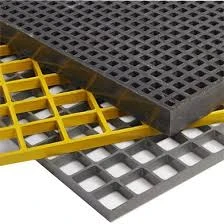loading...
- No. 9, Xingyuan South Street, Dongwaihuan Road, Zaoqiang County, Hengshui, Hebei, China
- admin@zjcomposites.com
- +86 15097380338
- Welcome to visit our website!
frp u channel
Understanding FRP U Channels A Comprehensive Overview
In the world of construction and engineering, materials play a pivotal role in determining the efficiency, durability, and cost-effectiveness of various projects. One such material that has gained prominence is Fiber Reinforced Polymer (FRP). Specifically, the FRP U channel has emerged as a versatile and innovative component, finding applications across different industries due to its unique properties and benefits.
What is FRP?
Fiber Reinforced Polymer (FRP) is a composite material made of a polymer matrix that is reinforced with fibers, typically glass, carbon, or aramid. This combination results in a product that exhibits impressive strength-to-weight ratios, corrosion resistance, and flexibility, making it particularly suitable for environments that demand both performance and resilience.
The Structure of FRP U Channels
The U channel is a structural element characterized by its U-shaped cross-section, which provides inherent strength and stability. An FRP U channel is specifically designed to harness the benefits of fiber reinforcement, offering substantial load-bearing capacity while remaining lightweight. The design of the U channel allows for easy integration into various systems, whether as a standalone support element or as part of a more complex framework.
Applications of FRP U Channels
FRP U channels are utilized in a myriad of applications across diverse fields. Their resistance to environmental stressors, such as moisture, chemicals, and UV radiation, makes them ideal for use in
1. Construction In building structures, FRP U channels are often used as reinforcements in floors, roofs, and even walls. Their lightweight nature reduces the overall weight of construction, lessening the requirements for foundational support.
2. Transportation FRP U channels are employed in the manufacture of structural components for vehicles, such as trains and boats, where weight reduction is critical for enhancing fuel efficiency.
3. Electrical The electrical industry utilizes FRP U channels in the fabrication of raceways and supports for wiring systems, thanks to their non-conductive properties and resistance to corrosive environments.
frp u channel

4. Marine Applications Given their outstanding resistance to saltwater corrosion, FRP U channels find extensive use in marine construction, including docks, piers, and boatbuilding, proving invaluable in prolonged exposure to harsh conditions.
5. Telecommunications With the growing need for durable and reliable infrastructure, FRP U channels provide excellent solutions for supporting antennas and cable structures.
Advantages of FRP U Channels
The use of FRP U channels comes with a host of advantages
- Lightweight One of the most significant benefits of FRP materials is their low weight compared to traditional metals. This characteristic simplifies transportation and installation processes, lowering labor and logistics costs.
- Corrosion Resistance FRP is inherently resistant to corrosion, which drastically extends the lifespan of structures and reduces maintenance costs.
- High Strength Despite being lightweight, FRP U channels possess remarkable strength, allowing them to bear heavy loads effectively.
- Design Flexibility The manufacturing process of FRP allows for the production of customized shapes and sizes, enabling engineers and architects to create tailored solutions for specific projects.
- Thermal Stability FRP materials maintain their integrity over a wide range of temperatures, making them suitable for various environmental conditions.
Conclusion
In conclusion, FRP U channels represent a significant advancement in construction and engineering materials. Their unique blend of lightweight design, corrosion resistance, and structural strength opens up numerous possibilities across various industries. As the demand for sustainable and efficient materials continues to grow, the role of FRP and its applications, such as U channels, will undoubtedly expand, fostering innovation and enhancing the performance of future projects. Understanding and utilizing these materials effectively will be key for professionals seeking to optimize their designs and improve overall project outcomes.
-
The Rise of FRP Profiles: Strong, Lightweight, and Built to LastNewsJul.14,2025
-
SMC Panel Tanks: A Modern Water Storage Solution for All EnvironmentsNewsJul.14,2025
-
GRP Grating: A Modern Solution for Safe and Durable Access SystemsNewsJul.14,2025
-
Galvanized Steel Water Tanks: Durable, Reliable, and Ready for UseNewsJul.14,2025
-
FRP Mini Mesh Grating: The Safer, Smarter Flooring SolutionNewsJul.14,2025
-
Exploring FRP Vessels: Durable Solutions for Modern Fluid HandlingNewsJul.14,2025
-
GRP Structures: The Future of Lightweight, High-Performance EngineeringNewsJun.20,2025
